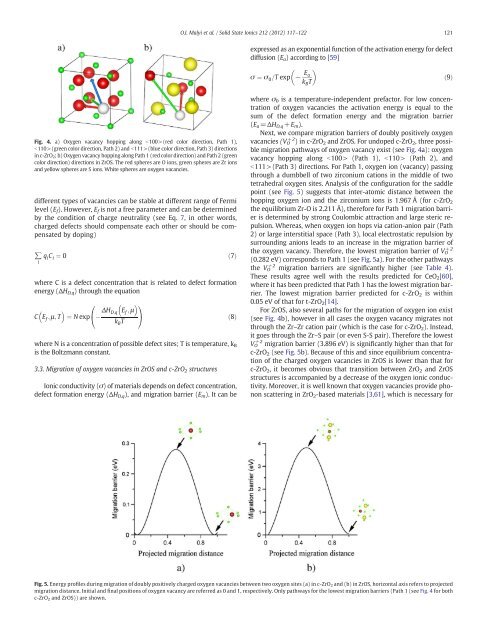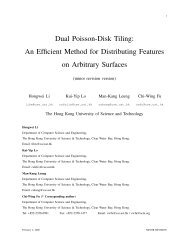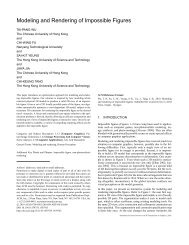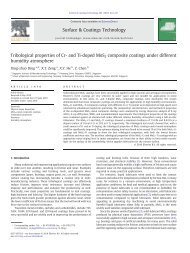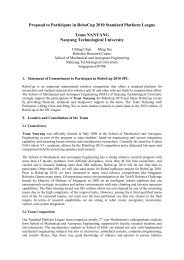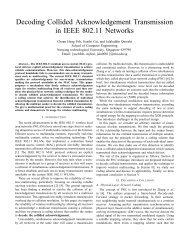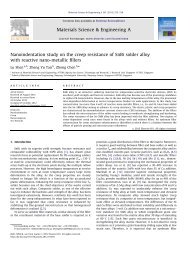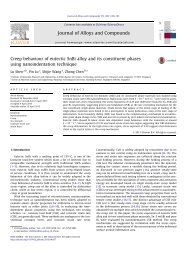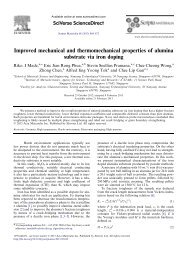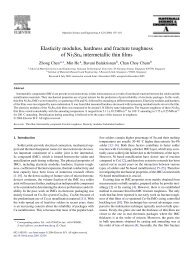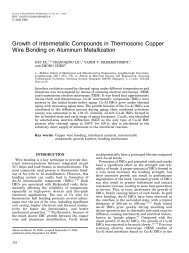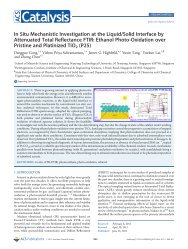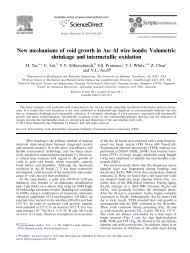Formation and migration of oxygen and zirconium vacancies in ...
Formation and migration of oxygen and zirconium vacancies in ...
Formation and migration of oxygen and zirconium vacancies in ...
Create successful ePaper yourself
Turn your PDF publications into a flip-book with our unique Google optimized e-Paper software.
Fig. 4. a) Oxygen vacancy hopp<strong>in</strong>g along b100>(red color direction, Path 1),<br />
b110>(green color direction, Path 2) <strong>and</strong> b111>(blue color direction, Path 3) directions<br />
<strong>in</strong> c-ZrO 2; b) Oxygen vacancy hopp<strong>in</strong>g along Path 1 (red color direction) <strong>and</strong> Path 2 (green<br />
color direction) directions <strong>in</strong> ZrOS. The red spheres are O ions, green spheres are Zr ions<br />
<strong>and</strong> yellow spheres are S ions. White spheres are <strong>oxygen</strong> <strong>vacancies</strong>.<br />
different types <strong>of</strong> <strong>vacancies</strong> can be stable at different range <strong>of</strong> Fermi<br />
level (Ef). However, Ef is not a free parameter <strong>and</strong> can be determ<strong>in</strong>ed<br />
by the condition <strong>of</strong> charge neutrality (see Eq. 7, <strong>in</strong> other words,<br />
charged defects should compensate each other or should be compensated<br />
by dop<strong>in</strong>g)<br />
∑ i<br />
q iC i ¼ 0 ð7Þ<br />
where C is a defect concentration that is related to defect formation<br />
energy (ΔH D,q) through the equation<br />
0<br />
1<br />
ΔHD;q Ef ; μ<br />
C Ef ; μ; T ¼ N exp@<br />
A ð8Þ<br />
kBT where N is a concentration <strong>of</strong> possible defect sites; T is temperature, kB<br />
is the Boltzmann constant.<br />
3.3. Migration <strong>of</strong> <strong>oxygen</strong> <strong>vacancies</strong> <strong>in</strong> ZrOS <strong>and</strong> c-ZrO 2 structures<br />
Ionic conductivity (σ) <strong>of</strong> materials depends on defect concentration,<br />
defect formation energy (ΔHD,q), <strong>and</strong> <strong>migration</strong> barrier (Em). It can be<br />
O.I. Malyi et al. / Solid State Ionics 212 (2012) 117–122<br />
expressed as an exponential function <strong>of</strong> the activation energy for defect<br />
diffusion (E a) accord<strong>in</strong>g to [59]<br />
σ ¼ σ 0=T exp − E a<br />
k BT<br />
where σ0 is a temperature-<strong>in</strong>dependent prefactor. For low concentration<br />
<strong>of</strong> <strong>oxygen</strong> <strong>vacancies</strong> the activation energy is equal to the<br />
sum <strong>of</strong> the defect formation energy <strong>and</strong> the <strong>migration</strong> barrier<br />
(E a=ΔH D,q+E m).<br />
Next, we compare <strong>migration</strong> barriers <strong>of</strong> doubly positively <strong>oxygen</strong><br />
<strong>vacancies</strong> (V O +2 ) <strong>in</strong> c-ZrO2 <strong>and</strong> ZrOS. For undoped c-ZrO 2, three possible<br />
<strong>migration</strong> pathways <strong>of</strong> <strong>oxygen</strong> vacancy exist (see Fig. 4a): <strong>oxygen</strong><br />
vacancy hopp<strong>in</strong>g along b100> (Path 1), b110> (Path 2), <strong>and</strong><br />
b111>(Path 3) directions. For Path 1, <strong>oxygen</strong> ion (vacancy) pass<strong>in</strong>g<br />
through a dumbbell <strong>of</strong> two <strong>zirconium</strong> cations <strong>in</strong> the middle <strong>of</strong> two<br />
tetrahedral <strong>oxygen</strong> sites. Analysis <strong>of</strong> the configuration for the saddle<br />
po<strong>in</strong>t (see Fig. 5) suggests that <strong>in</strong>ter-atomic distance between the<br />
hopp<strong>in</strong>g <strong>oxygen</strong> ion <strong>and</strong> the <strong>zirconium</strong> ions is 1.967 Å (for c-ZrO2<br />
the equilibrium Zr-O is 2.211 Å), therefore for Path 1 <strong>migration</strong> barrier<br />
is determ<strong>in</strong>ed by strong Coulombic attraction <strong>and</strong> large steric repulsion.<br />
Whereas, when <strong>oxygen</strong> ion hops via cation-anion pair (Path<br />
2) or large <strong>in</strong>terstitial space (Path 3), local electrostatic repulsion by<br />
surround<strong>in</strong>g anions leads to an <strong>in</strong>crease <strong>in</strong> the <strong>migration</strong> barrier <strong>of</strong><br />
the <strong>oxygen</strong> vacancy. Therefore, the lowest <strong>migration</strong> barrier <strong>of</strong> VO +2<br />
(0.282 eV) corresponds to Path 1 (see Fig. 5a). For the other pathways<br />
the VO +2 <strong>migration</strong> barriers are significantly higher (see Table 4).<br />
These results agree well with the results predicted for CeO2[60],<br />
where it has been predicted that Path 1 has the lowest <strong>migration</strong> barrier.<br />
The lowest <strong>migration</strong> barrier predicted for c-ZrO2 is with<strong>in</strong><br />
0.05 eV <strong>of</strong> that for t-ZrO 2[14].<br />
For ZrOS, also several paths for the <strong>migration</strong> <strong>of</strong> <strong>oxygen</strong> ion exist<br />
(see Fig. 4b), however <strong>in</strong> all cases the <strong>oxygen</strong> vacancy migrates not<br />
through the Zr–Zr cation pair (which is the case for c-ZrO2). Instead,<br />
it goes through the Zr–S pair (or even S-S pair). Therefore the lowest<br />
VO +2 <strong>migration</strong> barrier (3.896 eV) is significantly higher than that for<br />
c-ZrO 2 (see Fig. 5b). Because <strong>of</strong> this <strong>and</strong> s<strong>in</strong>ce equilibrium concentration<br />
<strong>of</strong> the charged <strong>oxygen</strong> <strong>vacancies</strong> <strong>in</strong> ZrOS is lower than that for<br />
c-ZrO 2, it becomes obvious that transition between ZrO 2 <strong>and</strong> ZrOS<br />
structures is accompanied by a decrease <strong>of</strong> the <strong>oxygen</strong> ionic conductivity.<br />
Moreover, it is well known that <strong>oxygen</strong> <strong>vacancies</strong> provide phonon<br />
scatter<strong>in</strong>g <strong>in</strong> ZrO2-based materials [3,61], which is necessary for<br />
Fig. 5. Energy pr<strong>of</strong>iles dur<strong>in</strong>g <strong>migration</strong> <strong>of</strong> doubly positively charged <strong>oxygen</strong> <strong>vacancies</strong> between two <strong>oxygen</strong> sites (a) <strong>in</strong> c-ZrO2 <strong>and</strong> (b) <strong>in</strong> ZrOS, horizontal axis refers to projected<br />
<strong>migration</strong> distance. Initial <strong>and</strong> f<strong>in</strong>al positions <strong>of</strong> <strong>oxygen</strong> vacancy are referred as 0 <strong>and</strong> 1, respectively. Only pathways for the lowest <strong>migration</strong> barriers (Path 1 (see Fig. 4 for both<br />
c-ZrO 2 <strong>and</strong> ZrOS)) are shown.<br />
121<br />
ð9Þ


